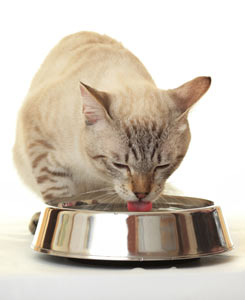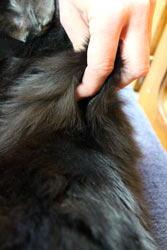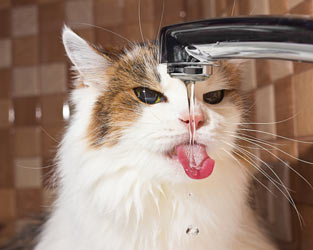Dehydration in Cats: How Can You Tell If a Cat Is Dehydrated?

Dehydration means that a cat has either used or lost more fluids than her body needs to perform basic metabolic functions, without replacing them through drinking. Dehydration also results in electrolyte loss. This decrease in fluids and electrolytes negatively affects circulation, digestion, and toxin removal from the body. If it is severe enough, it can result in organ failure and death.
Ways a Cat May Lose Too Many Fluids
- By overheating in hot weather
- Through vomiting
- By having excessive diarrhea
- Through a metabolic disorder such as kidney disease, diabetes, or hyperthyroidism.
- Because of a fever
- Through blood loss
Reasons a Cat May Not Take in Enough Fluid
- Cats in the wild are carnivores. They get most of their moisture from the prey that they eat, and as a result they have a low thirst drive.
- Because cats do not have much of an urge to drink water, it is very easy for them to become dehydrated quickly, especially if they are fed dry food.
- Cats that are ill may not drink enough water because they feel nauseous or too lethargic to move around.
- Cats that become lost or accidentally locked in an area without water may become dehydrated.
- Cats that are left outdoors without access to fresh water may not be able to find an adequate source.
- Cats may not like the source of water that is available to them. Cats are very sensitive to smells and may not like the smell of the chemicals in tap water. Many cats prefer drinking running water to standing water, and some have very definite preferences for the type of bowl that their water is presented to them in.
Why Is It Important to Know If Your Cat Is Dehydrated?
Cats that are dehydrated begin to feel lethargic. Then they don't want to eat and drink or move around, so they become more dehydrated. In this way, dehydration can start a vicious cycle, and if it is untreated, it can lead to organ failure.
When a cat's dehydration is caused by an underlying illness, it is important to know that your cat is sick so that appropriate treatment can be started.
Treatment of Dehydration in Cats
The cornerstone of the treatment of dehydration in cats is fluid replacement. This can be done orally if the pet is not vomiting and has no underlying disease process complicating things. If the cat will not take fluid in orally or can't keep it down because of vomiting, fluids may need to be given another way. The two most common parenteral (delivered in a way other than through the GI tract) ways of giving fluids are subcutaneously (deposited under the skin) and intravenously (injected directly into a vein).
The second goal of treatment should be directed at resolving the underlying cause of the dehydration. If this was overheating or increased exercise, the treatment might simply be to ensure that there is clean, fresh water available for your cat at all times. If a bout of vomiting caused the dehydration, your veterinarian may treat your cat with anti-emetics or other medications.
If a chronic condition such as kidney disease is causing your cat to consistently be at risk for dehydration, you may need to replace fluids on a regular basis. Subcutaneous fluids may need to be given routinely. You can learn to do this at home.
How to Tell If Your Cat Is Dehydrated
There are some basic ways to tell at home if your cat might be dehydrated:
- Look at her eyes: If your cat's eyes are sunken into the sockets and appear dull instead of shiny, it's likely that she is dehydrated.
- Do a skin tent test: Proper hydration helps a cat's skin remain elastic and supple. A dehydrated cat's skin may not rebound as quickly as that of a well-hydrated cat when you pull it up. A good place to check this is between the shoulder blades, where there is a good bit of extra skin. Using your thumb and first two fingers, pull some skin up just a bit to make a tent shape, then let go and watch how fast it rebounds to its normal position. It should do so within one second. A dehydrated cat's skin will not rebound as quickly as a well-hydrated cat's. An extremely dehydrated cat's skin may not rebound at all. This test can be tricky to interpret and takes some practice getting to know what normal is. Do not rely on it alone to determine if your cat is dehydrated . . . if your cat shows signs of illness, consult your veterinarian.
-
Check your cat's gums:
- When a cat is well-hydrated, her gums are pink and moist. If the gums appear dry and feel sticky when you touch them, your cat may be dehydrated.
- When you push lightly on the gum with your finger, then remove it, a blanched area will appear on the gum. The blanched area should disappear, returning to pink, in one to two seconds in a well-hydrated cat. If it takes longer, your cat may be dehydrated.
- Cats that are ill may be less compliant about handling than usual. Be sure to use care when attempting to look in your cat's mouth, and stop immediately if she acts upset.
- Consider the saliva: A well-hydrated cat's saliva is thin and mostly unnoticeable. If you see thick, more ropey saliva, it may indicate dehydration.
- Check your cat's litterbox: A dehydrated cat may become constipated. This may mean that you don't see stool in the litterbox, you see several small, very hard pieces of stool, or you see small pieces of stool outside of the litterbox.

These signs of dehydration are more non-specific and can occur during a variety of illnesses:
- Lethargy
- Loss of appetite
- Increased heart rate
Most importantly, they encourage cats to drink more water, which is good for their health. Order now!

Preventing Dehydration in Cats

- Cats can be finicky about how they obtain their water, so it helps if you can observe your cat during times of normal hydration to learn her preferences. Some cats only like glass bowls, some like running water rather than standing water, some like tap water, and others prefer bottled.
- Make sure that you clean your cat's water bowl every day to discourage bacteria from growing on its surface.
- Some cats prefer shallow but large bowls so their whiskers aren't disturbed while they're drinking.
- For cats that love running water, you may consider a Drinkwell Pet Fountain. This can minimize the need for you to run a faucet constantly and have your cat sitting in your sink all the time.
- If possible, and with your veterinarian's approval, feed your cat canned foods. They contain up to 80% moisture and can help to compensate for your cat's low thirst drive.
- If your cat has had a bout of vomiting, don't offer her a large amount of water right away. She may drink too much at once and trigger more vomiting, leading to greater dehydration than she would have experienced otherwise. Limit her water and food to small amounts every hour or two for the rest of the day. If your cat vomits more than once or twice, contact your veterinarian right away.
- If your cat goes outside, make sure she has access to a cool place in hot weather and shelter in cold weather, with plenty of clean, fresh water at all times.
- Taking your cat to the veterinarian routinely for exams and any recommended testing such as blood work can help you catch and begin treating any underlying problems such as diabetes or kidney disease early, before they result in dehydration.
Dehydration in cats can rapidly lead to greater illness. Understanding cats' low thirst drive, knowing how to identify the signs of dehydration, and calling the veterinarian quickly if your cat is ill or seems dehydrated will go a long way toward helping your cat feel better much more quickly.
You May Also Like These Articles:
Should You Get Your Cat a Water Fountain?
Giving Your Cat Clean and Fresh Water
Subcutaneous Fluid Therapy: Giving Your Cat Fluids at Home
Notice: Ask-a-Vet is an affiliated service for those who wish to speak with a veterinary professional about their pet's specific condition. Initially, a bot will ask questions to determine the general nature of your concern. Then, you will be transferred to a human. There is a charge for the service if you choose to connect to a veterinarian. Ask-a-Vet is not manned by the staff or owners of CatHealth.com, and the advice given should not delay or replace a visit to your veterinarian.




